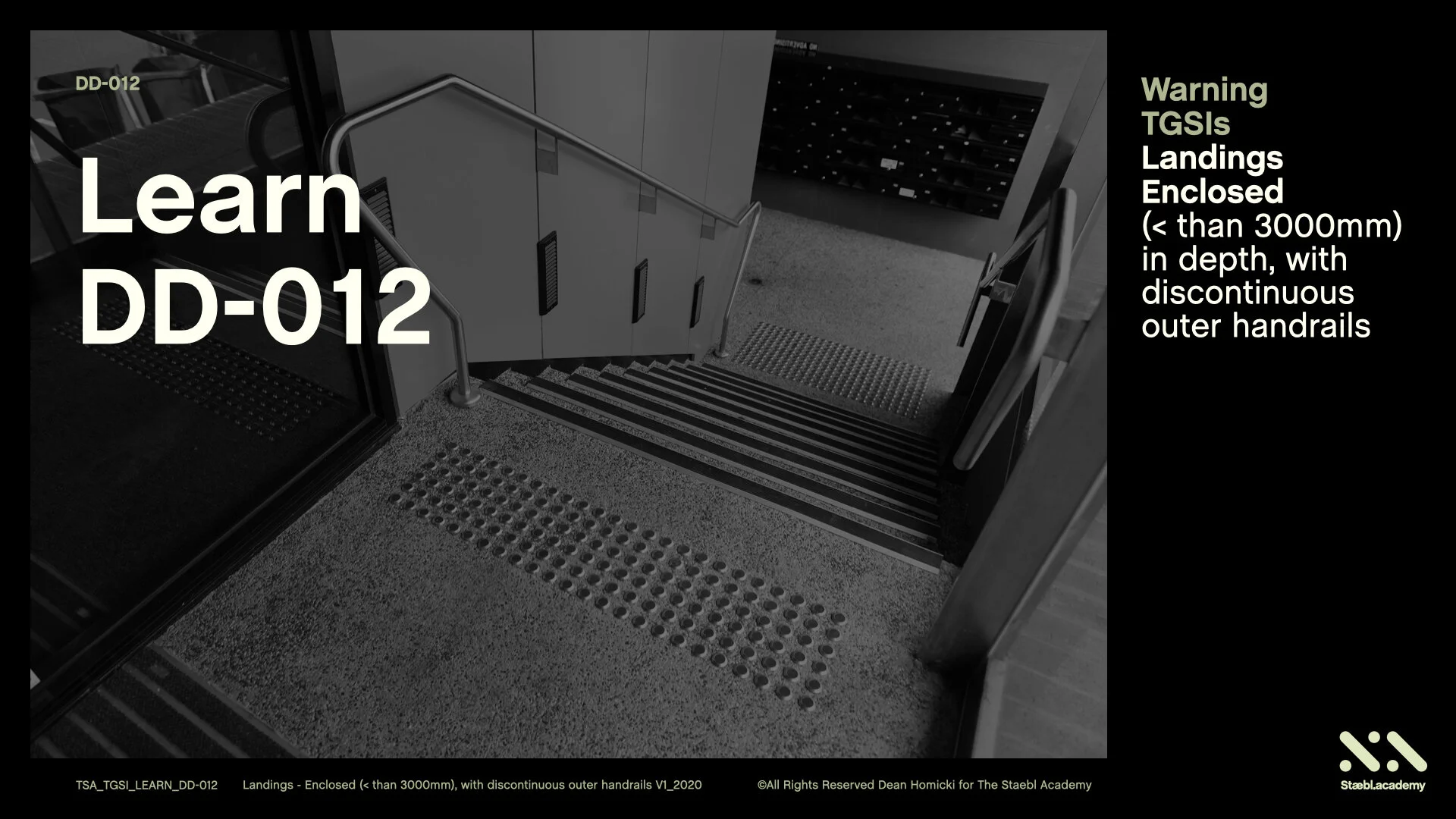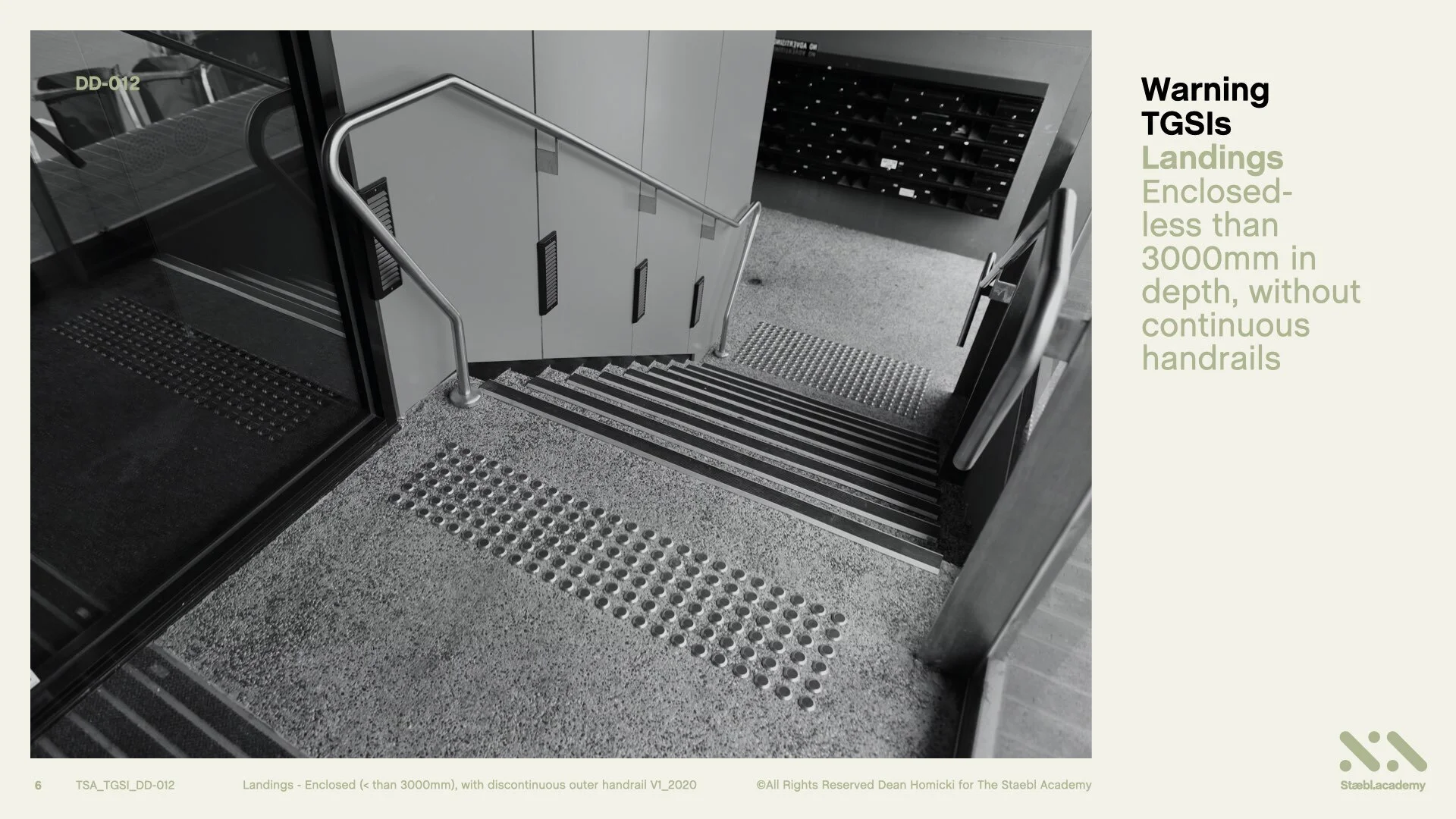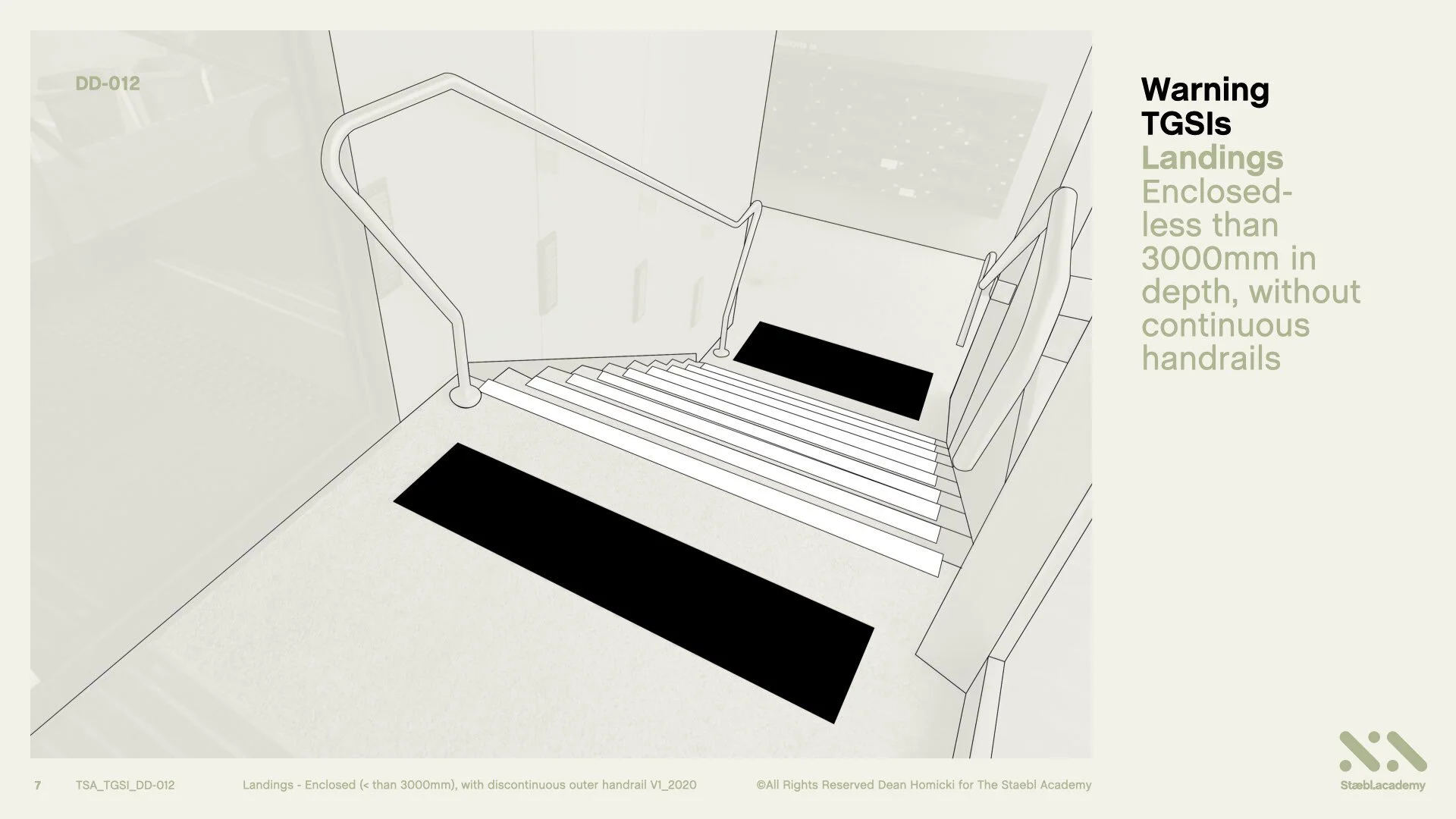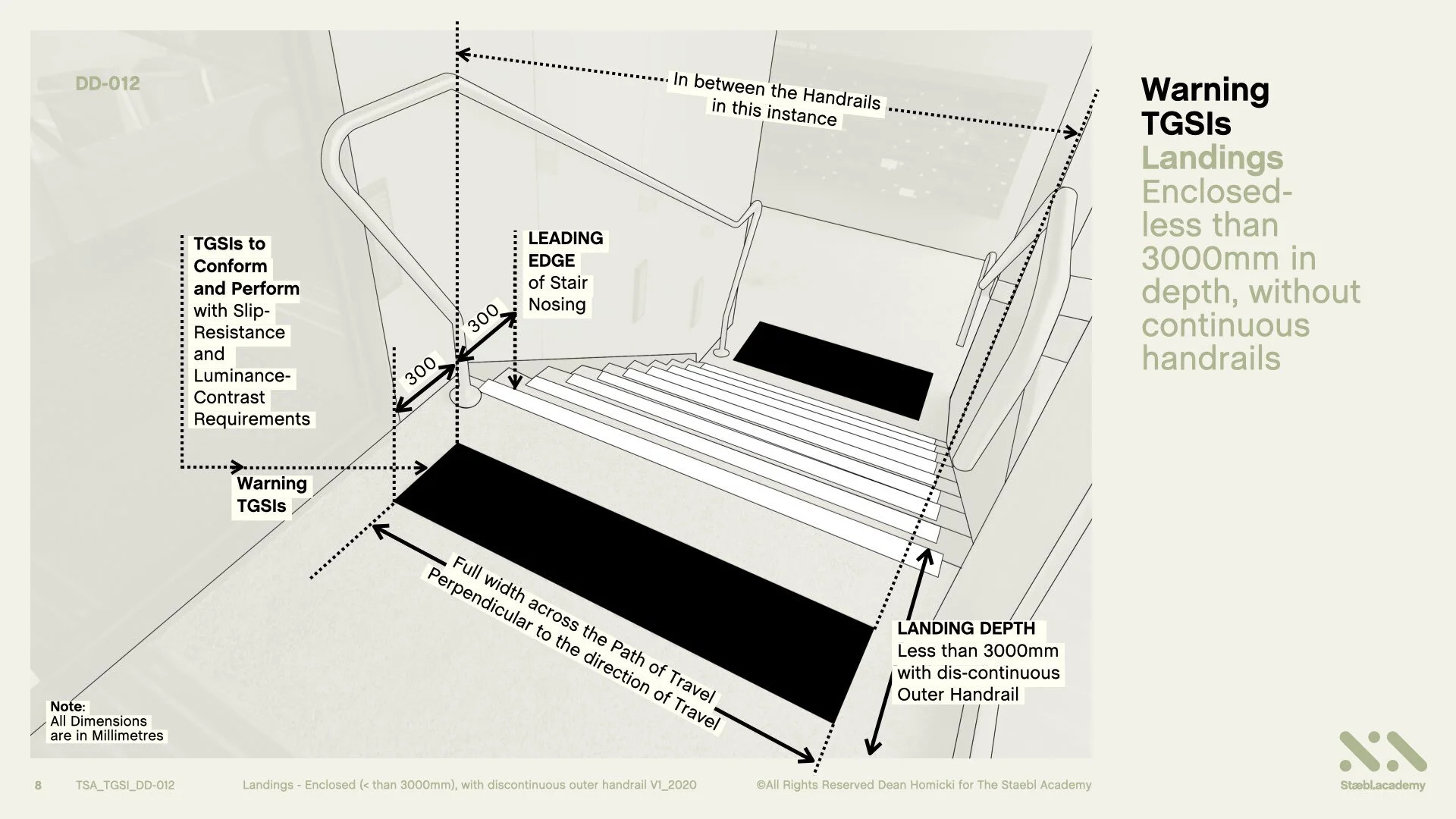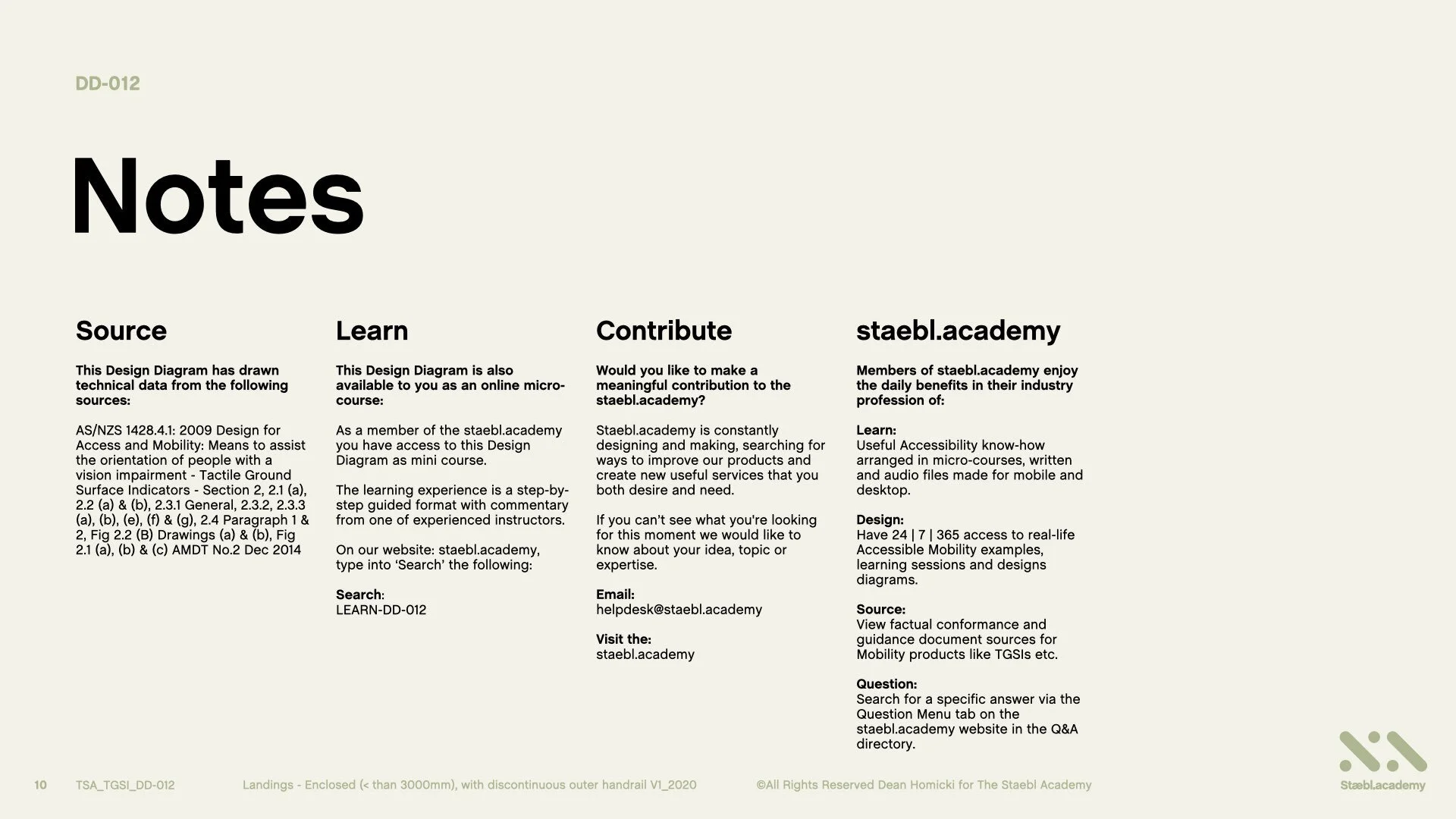Landings- Enclosed (< than 3000mm) in depth, with discontinuous outer handrails
Course: DD-012 | Length: 5:10 mins | Instructor: Dean Homicki
Chapters
00:33 - Learning Overview
02:03 - Learning Session
02:30 - Let’s Begin
04:26 - Learning Resources
Transcript
This learning session will cover the use of Warning TGSIs on a:
Stairway with an Open Landing and, an Enclosed Landing that is less than 3000mm in depth, with Dis-continuous outer handrails.
Welcome to staebl.academy TGSI Design Diagram 012. I’m Dean Homicki and I’ll be your guide for this course.
Learning Overview
Let’s review one type of use with TGSIs on an Open Landing (at the bottom) and an Enclosed landing (at the top) of the Stairway.
Both the Bottom and the Top approaches to the Stairway have dis-continuous handrails leading to landings that are less than 3000 mm in length. This is a public entrance to a residential building so let’s extract what the Australian TGSI Standard requires of the situation.
When a Stairway, Escalator or Moving Walkway, leads to an open area at the top or the bottom, is less than 3000 mm in depth, with NO continuous outer handrails, Warning TGSIs shall be, set back 300 mm with a tolerance of +/- 10mm, from the outer leading edge of the Stair Nosing, to a minimum depth of 300 mm, for the full width across the Path of Travel and, must be perpendicular to the direction of travel.
TGSIs for this application shall also conform and perform, with the applicable Slip Resistance and Luminance Contrast Requirements.
Here is a real-life situation of a Staircase showing the Top and Bottom with Discrete Composite Warning TGSIs installed.
We are going to now convert this image it into a perspective line drawing and view how TGSIs have been used in this application.
Here’s the line drawing of the image.
Learning Session
How to use TGSIs in this situation.
In this example, people can approach this stairway from various angles at the Bottom and only one angle at the top of the Stairway.
For the orientation of persons who are blind or vision impaired, applying this knowledge enables us to determine how to use TGSIs and conform to the Normative and Informative Guidelines of the Australian TGSI standards.
Let’s Begin
At the bottom of the Stairway, we have an ‘Open Area’ - that is, an area that is accessible at any angle of approach to the hazard. The hazard is the stairway.
At the top of the Stairway, we have an enclosed area that is only accessible from one angle of approach. This enclosed landing is less than 3000 mm in depth.
To the left of ‘Enclosed Area’ is an automated entrance door to the premises. This is, an area that is accessible at only one angle of approach to the hazard. The area is surrounded by walls on the right and back sides of the landing.
To the left of the ‘Enclosed Area’ is an automated entrance door to and from the premises.
As the landing is only accessible at one angle of approach to and from the automated entrance door and is less than 3000 mm in depth, the TGSI application is measured from the start of the leading edge of the Stair Nosing, or (the face of the Stair ‘Riser’ if the Stair nosing if recessed into the going (or step), of the stair.
We require Warning TGSIs to be set back from the face of the stair or the edge of the stair nosing, 300 mm with a tolerance of +/- 10 mm, for a minimum depth of 300 mm. This equates to 6 TGSI nodes at 50 mm spacings. And for the full width across the Path of Travel and must be perpendicular to the direction of travel.
As the staircase has handrails installed on each side of the stair, the TGSIs shall be installed in between the Handrails in this instance, as this is the accessible path of travel.
TGSIs for this application shall also conform and perform, with the applicable Slip Resistance and Luminance Contrast Requirements.
And here is a real-life TGSI application once more.
Learning Resources
That’s the conclusion for Warning TGSIs, Stair Top and Bottom Landings that are Enclosed and Open, and are less than 3000 mm in depth, with dis-continuous outer handrails.
You can also access this course as a concise series of design diagrams in the resource section of our website staebl.academy/design. To access this resource now, click on the link below this video.
Thanks for joining me here at the staebl.academy. I look forward to guiding you through another learning session in the near future. Bye for now.
Listen
Click/Tap the audio player below to listen to the written transcript of this design session as an audible version. This is a streamed broadcast from the Staebl.academy site.
Diagrams
Click/Tap on an image from this learning session to view it as a larger picture. You will then be able to scroll through each individual design diagram in this slide-deck for a closer inspection.
Sources
TSA-TGSI-LEARN-DD-012 - This staebl.academy course module has drawn information from the following sources:
AS/NZS 1428.4.1: 2009 Design for Access and Mobility: Means to assist the orientation of people with a vision impairment - Tactile Ground Surface Indicators - Section 2, 2.1 (a), 2.2 (a) & (b), 2.3.1 General, 2.3.2, 2.3.3 (a), (b), (e), (f) & (g), 2.4 Paragraph 1 & 2, Fig 2.2 (B) Drawings (a) & (b), Fig 2.1 (a), (b) & (c) AMDT No.2 Dec 2014


